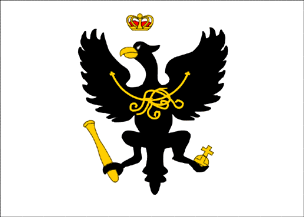Now we are getting a bit closer to the history of Prussian nobility. As you’ve seen so far, it is first important to see the historical development of Prussia itself before you can understand its line of nobility and peerage which was heavily influenced by political ties with its neighbors. The union of the Duchy of Prussia and the Margraviate of Brandenburg in 1701 formed the Kingdom of Prussia, which was created when Elector Frederick III assumed the title of Frederick I, King in Prussia, on 18 January 1701.
Prussian Arms of 1702
The crowned eagle in the center is the Prussian coat of arms (also used on its flag below) integrated into the greater escutcheon representing the 25 royal families. The 'FR' on the eagle's breast represents Fridericus Rex or King Frederick (see the Prussian flags below).
The Prussian coat of arms, Frederick's family shield (below the coat of arms) and the entire escutcheon are each crowned. The electoral sceptor on a blue shield tops the coat of arms. Notice that the "wild men" are looking at the viewer.
The Prussian coat of arms, Frederick's family shield (below the coat of arms) and the entire escutcheon are each crowned. The electoral sceptor on a blue shield tops the coat of arms. Notice that the "wild men" are looking at the viewer.
Frederick I (whose first wife was Spanish) adopted this royal title after pledging allegiance against France, who was attempting to hinder Spain’s succession to the throne – which in turn could have threatened the entire balance of power in all of Europe. This conflict involved interestingly enough, North America’s fight for control over its continent (see Queen Anne’s War).
The young kingdom was very poor and had not completely recovered from the Thirty Years’ War. On top of that, nearly one third of the Duchy of Prussia alone fell victim to the bubonic plague in 1708,which had almost reached the capitol of Berlin by 1710, but thankfully receded before Berlin might well have been greatly decimated, royalty included.
The young kingdom was very poor and had not completely recovered from the Thirty Years’ War. On top of that, nearly one third of the Duchy of Prussia alone fell victim to the bubonic plague in 1708,which had almost reached the capitol of Berlin by 1710, but thankfully receded before Berlin might well have been greatly decimated, royalty included.
Prussian Arms 1709
The Prussian arms were changed in 1709 after Frederick decided to integrate the shields of the Mecklenburg dukes into the larger escutcheon to make sure that his rights to the regions belonging to the Mecklenburg-Schwerin and Mecklenburg-Strelitz dukes in the case that their family lines should die out.
The main eschutcheon now has 36 quarters topped by a crowned helmet. The electoral scepter in its blue shield is now a bit higher than previously and the "wild men" are now holding banners of the Kingdom of Prussia and of Brandenburg (notice that the one bearing Brandenburg's banner is looking at the other, perhaps suggesting its tributary position to Prussia??). A pedestal has been added with the words God with us (German - Gott mit uns) and a pennant now tops the crest with Prussia's black eagle topping the entire Coat of arms, representing the Order of the Black Eagle, formed in 1701. The order's badge (blue cross) is seen at the pedestal.
Prussian Small Arms of 1790
A series of wars against against Sweden (the Great Northern War, 1700-1721), Silesia (War of the Austrian Succession, 1740-1748), Saxony and Bohemia (Seven Years' War, 1756-1757), Prussia’s kingdom underwent various phases of growth and increased in strength and influence, ending for the time being with the last partitioning of Poland in 1795 and thus forming the new territorial Provinces of New Silesia, South Prussia, and New East Prussia.
As you can see below, the Kingdom of Prussia underwent various changes seen through the slight changes in its flags.
Kingdom of Prussia’s flag in 1701 with a fancier filigree 'FR'
scepter replacing the globe and a sword replacing the smaller scepter.
(notice the missing 'FR' and the simpler scepter)









 Buying Nobility - Noble Titles for Sale (GALLERY)
Buying Nobility - Noble Titles for Sale (GALLERY)








No comments:
Post a Comment